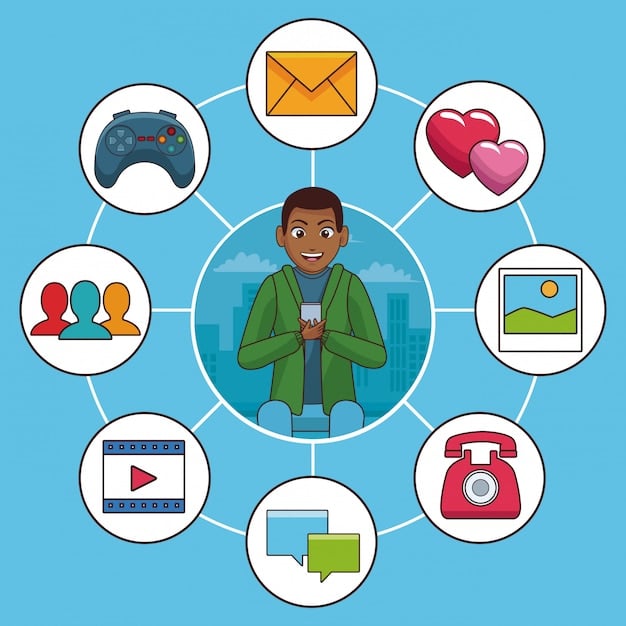Social Media and the Attention Economy: Winning Back Your Focus

Social media platforms are locked in a fierce competition for our attention, employing various strategies from endless scrolling to personalized content to keep users engaged, impacting our productivity and well-being as we navigate this attention economy.
The digital landscape is dominated by social media platforms, each vying for our attention. Understanding the dynamics of the social media and the attention economy: how platforms are competing for your time and focus is crucial for navigating this digital age and reclaiming control over our time and focus.
Understanding the Attention Economy
The attention economy is a concept that treats human attention as a scarce commodity. In the digital age, where information is abundant, our focus has become the most valuable asset. Social media platforms thrive in this economy by capturing and retaining user attention.
What is the Attention Economy?
The attention economy is driven by the principle that attention is limited. Social media companies employ various techniques to maximize the time users spend on their platforms, including personalized content, notifications, and interactive features.
The Rise of Social Media
The proliferation of social media has intensified the competition for attention. Platforms such as Facebook, Instagram, Twitter, and TikTok constantly innovate to keep users engaged and coming back for more.

Here are some strategies social media platforms use to capture attention:
- Personalized Content: Algorithms analyze user data to deliver content tailored to individual preferences, increasing engagement.
- Endless Scrolling: Infinite scroll features keep users browsing longer without the need to click to the next page, keeping them on the platform.
- Notifications: Push notifications alert users to new content, messages, and interactions, drawing them back to the app.
The attention economy highlights the need for users to be mindful of how they allocate their time and attention. By understanding the strategies employed by social media platforms, individuals can make more informed choices about their social media usage.
The Psychological Tactics Behind Engagement
Social media platforms leverage psychological principles to enhance user engagement. By understanding these tactics, users can become more aware of their influence and take steps to mitigate their impact.
Variable Rewards
Variable rewards, such as likes, comments, and shares, create a sense of anticipation and excitement. Users are more likely to keep checking their social media accounts to see if they have received any new interactions, feeding into the cycle.
Social Comparison
Social media often encourages users to compare themselves to others, leading to feelings of envy, inadequacy, or validation. Platforms exploit these emotions by curating content that triggers social comparison, prompting users to continue engaging.
Fear of Missing Out (FOMO)
FOMO is a powerful motivator that drives users to stay connected to social media. The fear of missing out on important information, social events, or trends keeps users glued to their devices.
Recognizing these psychological tactics is important for developing healthier social media habits. Users can set limits on their social media usage, unfollow accounts that trigger negative emotions, and focus on real-life experiences rather than chasing online validation.
The Impact on Productivity and Well-being
The constant barrage of notifications and updates from social media can negatively impact productivity and well-being. Understanding the effects of prolonged social media use can help individuals make informed decisions about their digital habits.
Decreased Focus and Concentration
Frequent interruptions from social media notifications disrupt focus and concentration, making it difficult to complete tasks. Multitasking between social media and work or study can reduce cognitive performance.
Increased Stress and Anxiety
The pressure to maintain an online presence, compare oneself to others, and stay up-to-date with social media trends can lead to increased stress and anxiety. Cyberbullying, negative comments, and online harassment can further exacerbate these issues.
Sleep Disturbances
Using social media before bed can interfere with sleep patterns due to the blue light emitted by screens and the stimulating nature of the content. Poor sleep quality can affect physical and mental health.

Mitigating the detrimental effects of social media requires a proactive approach:
- Set Time Limits: Use apps and tools to limit the amount of time spent on social media each day.
- Turn Off Notifications: Reduce distractions by disabling non-essential notifications.
- Practice Digital Detox: Take regular breaks from social media to recharge and reconnect with real-life activities.
- Mindful Usage: Be conscious of the content you consume and avoid engaging in negative or draining interactions.
By taking these steps, individuals can reduce the negative impact of social media on their productivity and well-being. Creating a balance between digital engagement and real-life experiences is crucial for maintaining a healthy lifestyle.
Platform Strategies for Dominating Attention
Social media platforms employ various strategies to maintain their dominance in the attention economy. These tactics range from algorithm optimization to content diversification, all aimed at keeping users engaged.
Algorithm Optimization
Social media algorithms are constantly refined to deliver content that is most likely to capture user attention. Platforms analyze user data to understand preferences and tailor feeds accordingly.
Content Diversification
Platforms diversify their content offerings by introducing new features such as stories, reels, and live videos. This variety keeps users engaged and coming back for more.
Gamification
Gamification elements, such as badges, points, and leaderboards, are used to incentivize user engagement. These features tap into the competitive nature of users, encouraging them to spend more time on the platform.
Social media platforms adapt to changes in user behavior and technological advancements to maintain their grip on attention. Understanding these strategies can help users navigate the digital landscape more effectively.
Cultivating Mindful Social Media Habits
Developing mindful social media habits is essential for reclaiming control over one’s attention and well-being. This involves being aware of one’s usage patterns and making conscious choices about online interactions.
Setting Boundaries
Setting clear boundaries around social media usage is crucial. This includes determining specific times for checking social media and sticking to those limits. Using apps and tools to track and manage time spent on social media can be helpful.
Curating Your Feed
Being selective about the accounts you follow and the content you consume can significantly impact your social media experience. Unfollow accounts that trigger negative emotions or promote unrealistic expectations and focus on content that is informative, inspiring, or uplifting.
Engaging in Real-Life Activities
Prioritizing real-life activities over social media engagement can help reduce dependency on digital validation. Spending time with friends and family, pursuing hobbies, and engaging in physical exercise can provide a sense of fulfillment and purpose.
Adopting a mindful approach to social media enables users to harness its benefits without succumbing to its negative effects. Cultivating healthy digital habits can lead to improved focus, well-being, and overall quality of life.
The Future of the Attention Economy
The attention economy continues to evolve as technology advances and user behavior changes. Understanding emerging trends and potential challenges is crucial for navigating the future of social media.
Augmented Reality (AR) and Virtual Reality (VR)
AR and VR technologies have the potential to further immerse users in digital experiences, intensifying the competition for attention. Platforms are exploring ways to integrate AR and VR features to enhance engagement and create new avenues for capturing user focus.
Artificial Intelligence (AI)
AI is being used to personalize content, predict user behavior, and optimize engagement strategies. As AI becomes more sophisticated, it will play an increasingly important role in shaping the attention economy.
Ethical Considerations
As social media platforms become more powerful, ethical considerations surrounding data privacy, content moderation, and user well-being are gaining prominence. Addressing these ethical concerns will be essential for fostering a responsible and sustainable digital ecosystem.
The future of the attention economy will be shaped by technological innovations, evolving user expectations, and ethical considerations. By staying informed and proactive, individuals can navigate the digital landscape with greater awareness and control.
| Key Point | Brief Description |
|---|---|
| 🤔 Attention Economy | Treats attention as a scarce resource, driving social media strategies. |
| 📱 Platform Tactics | Algorithms, personalized content, and notifications to maximize engagement. |
| 🧠 Psychological Impact | Variable rewards and social comparison influencing user behavior. |
| ⏰ Mindful Habits | Setting boundaries and curating feeds for healthier social media use. |
Frequently Asked Questions
▼
The attention economy is a system where human attention is treated as a scarce commodity. Social media platforms compete for this attention by using various engagement tactics.
▼
Platforms use personalized content, endless scrolling, and notifications to keep you engaged. These features are designed to maximize the time you spend on their sites.
▼
They leverage variable rewards, social comparison, and FOMO (fear of missing out) to keep you hooked. These tactics play on your emotions and desires.
▼
Frequent notifications and updates disrupt your focus, leading to decreased concentration. Multitasking between social media and tasks reduces cognitive performance.
▼
Set time limits, curate your feed, and engage in real-life activities. These steps will help you regain control over your attention and improve your well-being.
Conclusion
In conclusion, the battle for attention in the digital age is fierce, with social media platforms employing various strategies to capture and retain user engagement. Understanding these tactics and cultivating mindful social media habits are essential steps for reclaiming control over one’s time and focus, ultimately fostering a healthier and more balanced digital lifestyle.





